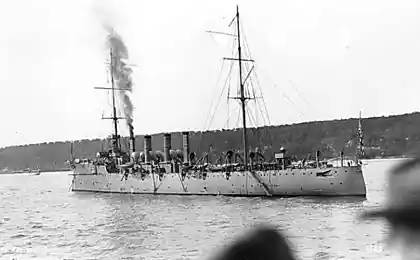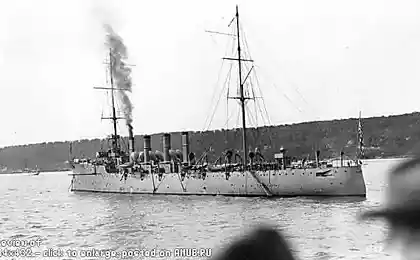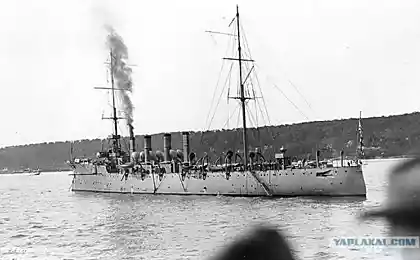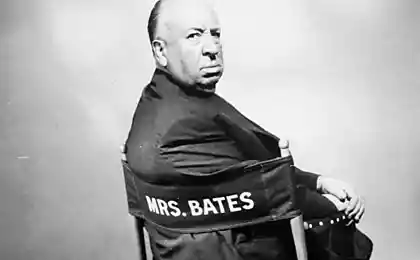1519
Airplane Anthony Rolta (14 photos)
If Anthony Peter Roylansa Rolta (Anthony Peter Roylance Rolt) was asked about his profession, he would have to think about. Before the war, he would have said: "soldiers". After the war - "racer", and after 1955 - "designer". But Anthony Rolta profession for us, in some way, is not very important. It is important that this man did, but rather what he was trying to do.
He was born October 16, 1918 in a wealthy family, studied at Eton, and then - at the military academy Sendhёrst (this is a very prestigious university, I tell you), was fond of motor racing (in 1939 won the prestigious British Empire Trophy race at the wheel ERA), and then, as a lieutenant, he went to war. Of them were sent to Calais to help the retreating British troops: Anthony commanded infantry brigade.
But the Germans were sent to Calais tanks, infantry, and nothing has been able to do with them. Rolta brigade went last - and he stayed until the very end. May 26, 1940 he was wounded and captured. And there was a legend. Because Anthony Peter Rolt 8 times tried to escape from Nazi camps.
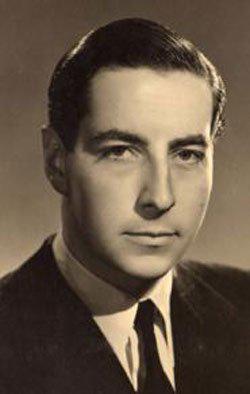
7 Rolta Anthony shoots.
Everything stays in German captivity for Rolta turned the sole purpose for which he lived: to escape. Seven times (!) Rolt - either alone or with accomplices - tried to escape. He escaped from the temporary barracks where prisoners were locked, fled during transport - it has become, one might say, "hobby", a habit. The first attempt he made almost immediately after the capture - jumped into the ditch and ran away; leave it, oddly enough, had a long way - but was still caught. The second time Rolt tried to escape from the temporary camp Laufen (Laufen) - they are two more prisoners dug a tunnel under the wall, which was discovered when crawling.
He was transferred to the camp Biberach (Biberach), where they were teammates stole clothes from temporary workers who were building something in the camp - and tried to just go through the gate. They happened because this escape turned out the most offensive: Rolta and his companions took just a few meters from the border to neutral Switzerland, where they were tortured and hungry, faced with an ordinary patrol. At this time, a recidivist Rolta returned to Laufen and put in solitary confinement.
More Rolta later transferred to Poznan where he persuaded his comrades to throw across the moat around the camp wall ladder: the attempt was foiled by sentries. Rolta threw in Warburg (Warburg) - he tried to escape from there, repeating Biberahsky experience: stealing clothes from a plumber. All hailed him as Rolt already left the camp - and Rolt failed to respond because they do not know German. He was again taken. Rolt again tried to escape when they are, the prisoners were sent to work vnelagernye. Five people, including Tony, broke away from the rest of the group of prisoners and posing as local farmers (where they took a garment - history is silent). Deception was uncovered.
Seventh, the last escape attempt took place in a new camp in Aynshtadte (Eichstätt). Rolt miraculously stole a German soldier's uniform and tried to leave the camp in it. But here he was caught.
Eighth escape Anthony Rolta.
At the beginning of the war the Germans valued prisoners. And the indefatigable Englishman suffered as a result of their shoots much less than if he was in a concentration camp near the end of the war. Rolta along with other captured by the British in the feces was escorted into the most famous POW camp, Oflag IV-C, is housed in a Castle Colditz (Colditz, Germany, 40 kilometers from Leipzig). Here's a photo of the castle, made in 1945, American photographer:

In general, in the officers' camps, high security was not as bad as it could be. In 1941, with the permission of his superiors even prisoners held intracamp Olympic Games. The camp had its own orchestra of prisoners, as well as Polish choir. The prisoners organized a theater, and even - with the tacit consent of protection - quietly drove moonshine from the fact that concealed for lunch. The guards transferred prisoners fresh German newspapers. A French prisoner Frederick Gige radio designed to catch the latest UK news: the receiver was able to hide, they found him in the reconstruction of the castle until 1965!
A Rolt all eager to escape. It was in Colditz came to him crazy idea, which later brought him fame - and even served as the basis for a feature film. From Colditz Rolt conceived ... fly.
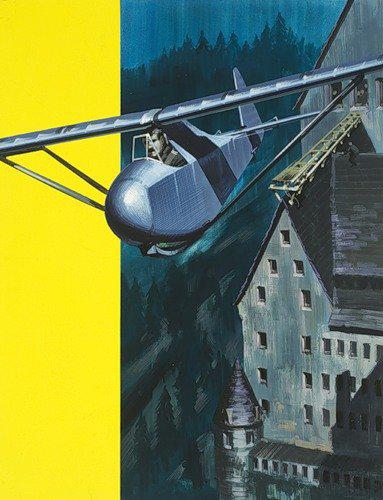
There were many difficulties. Colditz was conceived as a special camp for prisoners of war who are prone to numerous attempts to escape, as well as "difficult" prisoners. In this regard, the protection of the camp was extremely well thought-out - and significantly enhanced relative to ordinary POW camps. Moreover, Colditz Castle was situated on a high rocky hill great view all the neighborhood, and at night, with its towers and roof hit a powerful searchlight.
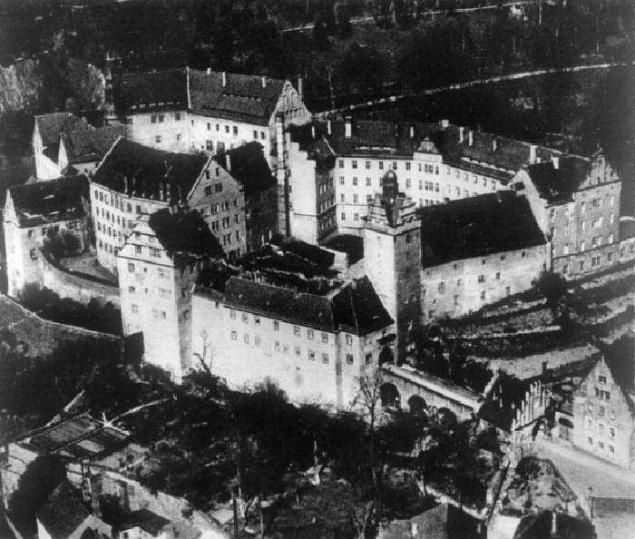
The prisoners were kept in Colditz from many different countries - Poland, France, Belgium, Holland, Great Britain and even Australia. The first prisoners arrived in Colditz in November 1940.
Courtyard garrison prison had only two exits, and the garrison consisted of about 200 well-armed soldiers. Second, the courtyard, where the windows cameras had direct access to the outside - it was connected with the garrison. Its walls were covered with barbed wire, and in the towers, day and night were armed with machine guards.
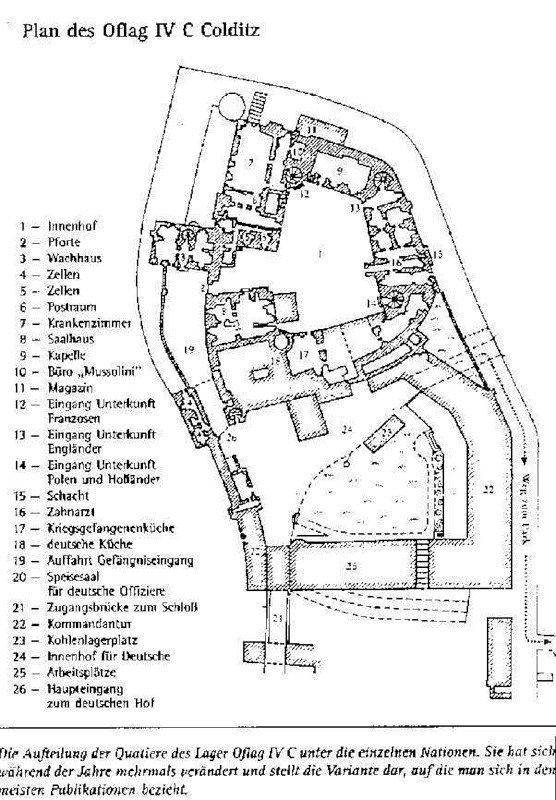
In the history of Colditz were committed 316 escape attempts (in German documents all cases are described thoroughly, with characteristic thoroughness the Germans). 31 runaway success. This is due to a large number of still that at the beginning of the war the Germans had a clear advantage, and not too afraid of traveling prisoners. Serious measures to prevent escapes and the horrors of the concentration camps began somewhat later. However, it is worth noting that just escaped from the castle, only 16 people, the rest successful escape from the city hospital committed or at the time of shipment. Moreover, 90% of the shoots were committed until 1942: then the Germans seriously stepped up security.
The prisoners fled, going through the barbed wire or lattice podpilivaya in narrow windows. Someone tried to escape through the catacombs. Officers tried not to kill when the shoots: the maximum shot in the legs, and then nursed in the camp hospital. Generally, between guards and prisoners there were a number of gentlemen's agreement, which followed those and others. For all the time only one escape suppression ended fatally - for the English Lieutenant Michael Sinclair. The Germans buried him in the camp cemetery with all due honors, covering the British flag and removing the helmet.
Colditz today:
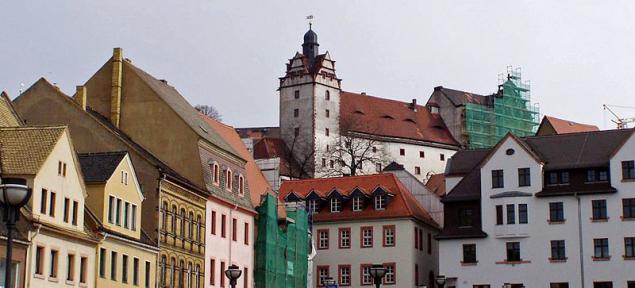
In Colditz Rolt together with another officer, David Walker, was July 14, 1943. There, in the camp they met Jack Best and Bill Goldfinch - officers who were transferred to Colditz after an unsuccessful attempt to escape from the other camp. Chetvёro comrades decided to run together, and their plan was really ambitious. Best and Goldfinch were military pilots and Rolt thanks to the passion for racing is very well versed in the art. They decided to build an airplane - or rather, the glider. Here is a portrait of Jack Best:
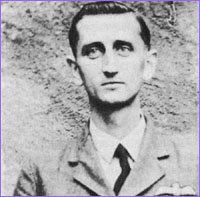
In the prison library (captured officers had access to books) Goldfinch found a guide to designing homemade aircraft - and the work started. Glider built in a limited space of the barracks - before the rear wall built another, fake, conceals about three feet of space, and the Germans did not notice the reduction of the area.
Plywood and wood they stole quietly in the workshops, where they worked - in particular, they used a few tables from which manufactured the wings flying machines of the future.
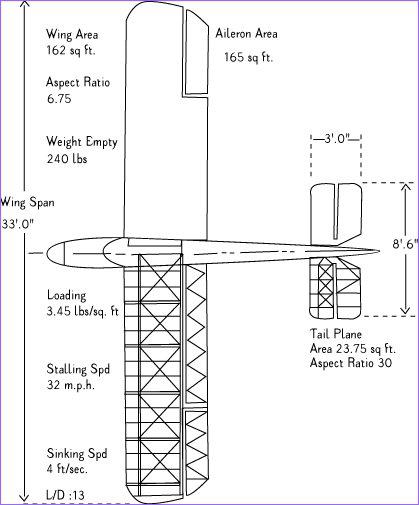
Used everything they could: rags and scraps of clothing, pieces of beds and floor boards. The glider was originally designed only for two - run were Rolt and Best, though worked on it for more than 40 people. The main task was to report information about friendly forces Colditz, his drawings, layouts guards and defense positions - the Allies could easily capture an impregnable fortress. Launching a glider they were going to carry out one of the towers of the castle. The tower loomed over the abyss: Falling down Glider time to dial the acceleration due to exit from the spin and fly farther. For the delivery of the airframe of the tower he was made collapsible - build it on the roof would take no more than 10 minutes. Separate same parts of the airframe could endure through a small hole in the wall disguised barracks. That is the only surviving photograph of the very glider:
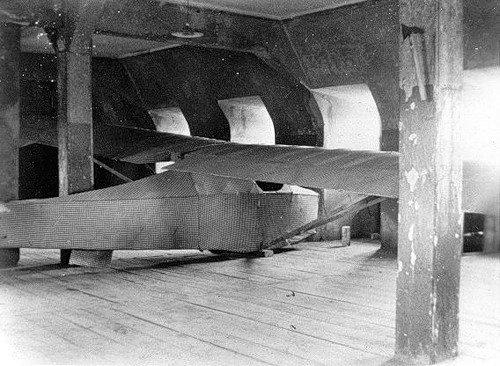
Wingspan glider was 9, 75 meters, length - 6 meters. Used for cladding prison sleeping bags. Tools by which made glider, also command respect - they are made from parts of the gramophone and kitchen knives.
It is worth noting that since April 5, 1943 Jack Best officially considered a fugitive. In fact, he was hiding in the closet next to the glider up to March 28, 1944: he wore and carried food waste from other prisoners. It happened to notice a German guard when Best stole some tools. Surprisingly, the fact that more than half the prisoner remained "ghost" is not forced the Germans to search the barracks.
They built a glider almost the entire 1944 - from January to October. He was ready - and was only waiting for the start. Of course, this was a terrible risk. No test, the abyss below, machines guards behind - and only one attempt. On board was written the name - "Kolditsky cock».
They do not have time. April 16, 1945 Colditz Castle was commissioned advancing troops allies (in this case the American part). Unchained Rolta sent home to England, as well as hundreds of other prisoners.
The museum Colditz still kept one of the parts of the airframe - the elevator. And in 1999, the stories and drawings Best, Goldfinch and Rolta has been made a replica of that same airframe - and held his Flight Test. Glider flew. To some extent Rolt even regretted that he was released, he could not himself to realize his dream - and run. Here are photos of the replica, which is now kept in the British Museum:
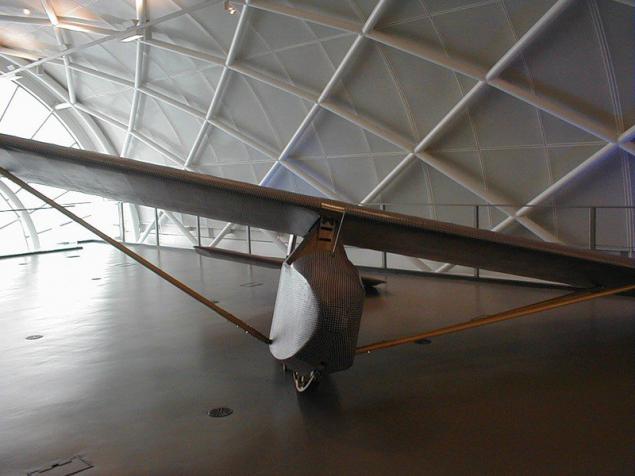
And here she is in flight:

However, he was a very modest man - and never thought his attempt to escape from Colditz something heroic. "It was my duty," - said Rolt.
In 1971, the story was filmed. Directed by Philip Leacock made the film "Man-bird» (The Birdmen). However, in the film heroes still managed to fly on your glider before the Americans arrived.
Afterword.
What happened after the war? Rolt received the British Military Cross for his heroism during the defense of Calais. And then left with his head in car racing.
In 1953, the duo Tony Rolt and Duncan Hamilton on the factory Jaguar C-Type won the famous race "24 Hours of Le Mans", ahead of the 4 circle closest rivals - the second crew team, Stirling Moss and Peter Walker. The following year, 1954, Rolt and Hamilton finished in second Le Mans, only losing to the winners circle - Gonzalez and Trintinyanu at Ferrari. The same "Jaguar»:
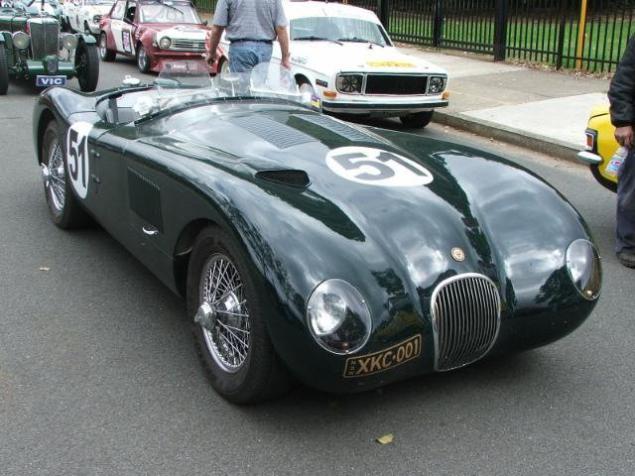
However, there was also another legend, which he himself did not like Rolt and frankly angry when someone asked him a question on this topic. In the qualification before the start of the race at Le Mans in 1953. The crew Rolt / Hamilton made a technical violation - and they were told that they would not have qualified. And this despite the fact that the "Jaguar" unequivocally claimed the victory, being one of the strongest teams of the time! With grief Rolt and Hamilton on the same evening went to a bar and drank until absolutely insane, being sure that they start tomorrow's race is not necessary. But the next morning companions were awakened by the news that they are admitted to the race, and their qualifying time restored! Probably driving both had a pretty tight ... But, as has been said, Rolt categorically denied this legend. Hamilton about it never really spread. Moreover, the race director of the team "Jaguar" Lofty England jokingly remarked: "Yes, you! I would never let them go to start drunk! You currently can not imagine how much I have problems from them even when they are sober ... "Here they are after the victory:
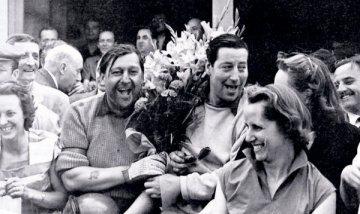
From 1950 to 1971 worked on Rolt-wheel drive vehicles, as a member, and then Director of Ferguson. In 1971 he founded his own laboratory. It was his firm FFD developed system AWD (all wheel drive) for the legendary sports prototype Jaguar XJ220, shown in 1988, as well as for the McLaren F1 supercar and many other cars. FFD collaborated with the world's largest car manufacturers: Ford, Chrysler, Audi, Fiat, General Motors.
Anthony Rolt passed away on 6 February 2008 in Warwick, England, at the age of 89 years. He lived a long life full of successes and failures, joys and sorrows. He won and lost, was a soldier and a racer, designer and businessman, but always moving forward. He was the last to stay alive participant of the first in the history of Grand Prix World Championship - GP Velikobritanii'1950, and the last member of the British club racers, joined the club before the war.
Sometimes it seems that the same glider still went out of their corkscrew - and flies somewhere in the infinite height, and from the cockpit us smiling brave Englishman Anthony Rolt.
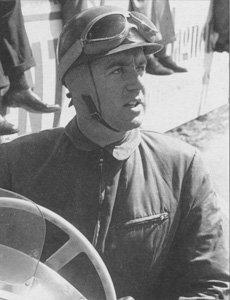
He was born October 16, 1918 in a wealthy family, studied at Eton, and then - at the military academy Sendhёrst (this is a very prestigious university, I tell you), was fond of motor racing (in 1939 won the prestigious British Empire Trophy race at the wheel ERA), and then, as a lieutenant, he went to war. Of them were sent to Calais to help the retreating British troops: Anthony commanded infantry brigade.
But the Germans were sent to Calais tanks, infantry, and nothing has been able to do with them. Rolta brigade went last - and he stayed until the very end. May 26, 1940 he was wounded and captured. And there was a legend. Because Anthony Peter Rolt 8 times tried to escape from Nazi camps.

7 Rolta Anthony shoots.
Everything stays in German captivity for Rolta turned the sole purpose for which he lived: to escape. Seven times (!) Rolt - either alone or with accomplices - tried to escape. He escaped from the temporary barracks where prisoners were locked, fled during transport - it has become, one might say, "hobby", a habit. The first attempt he made almost immediately after the capture - jumped into the ditch and ran away; leave it, oddly enough, had a long way - but was still caught. The second time Rolt tried to escape from the temporary camp Laufen (Laufen) - they are two more prisoners dug a tunnel under the wall, which was discovered when crawling.
He was transferred to the camp Biberach (Biberach), where they were teammates stole clothes from temporary workers who were building something in the camp - and tried to just go through the gate. They happened because this escape turned out the most offensive: Rolta and his companions took just a few meters from the border to neutral Switzerland, where they were tortured and hungry, faced with an ordinary patrol. At this time, a recidivist Rolta returned to Laufen and put in solitary confinement.
More Rolta later transferred to Poznan where he persuaded his comrades to throw across the moat around the camp wall ladder: the attempt was foiled by sentries. Rolta threw in Warburg (Warburg) - he tried to escape from there, repeating Biberahsky experience: stealing clothes from a plumber. All hailed him as Rolt already left the camp - and Rolt failed to respond because they do not know German. He was again taken. Rolt again tried to escape when they are, the prisoners were sent to work vnelagernye. Five people, including Tony, broke away from the rest of the group of prisoners and posing as local farmers (where they took a garment - history is silent). Deception was uncovered.
Seventh, the last escape attempt took place in a new camp in Aynshtadte (Eichstätt). Rolt miraculously stole a German soldier's uniform and tried to leave the camp in it. But here he was caught.
Eighth escape Anthony Rolta.
At the beginning of the war the Germans valued prisoners. And the indefatigable Englishman suffered as a result of their shoots much less than if he was in a concentration camp near the end of the war. Rolta along with other captured by the British in the feces was escorted into the most famous POW camp, Oflag IV-C, is housed in a Castle Colditz (Colditz, Germany, 40 kilometers from Leipzig). Here's a photo of the castle, made in 1945, American photographer:

In general, in the officers' camps, high security was not as bad as it could be. In 1941, with the permission of his superiors even prisoners held intracamp Olympic Games. The camp had its own orchestra of prisoners, as well as Polish choir. The prisoners organized a theater, and even - with the tacit consent of protection - quietly drove moonshine from the fact that concealed for lunch. The guards transferred prisoners fresh German newspapers. A French prisoner Frederick Gige radio designed to catch the latest UK news: the receiver was able to hide, they found him in the reconstruction of the castle until 1965!
A Rolt all eager to escape. It was in Colditz came to him crazy idea, which later brought him fame - and even served as the basis for a feature film. From Colditz Rolt conceived ... fly.

There were many difficulties. Colditz was conceived as a special camp for prisoners of war who are prone to numerous attempts to escape, as well as "difficult" prisoners. In this regard, the protection of the camp was extremely well thought-out - and significantly enhanced relative to ordinary POW camps. Moreover, Colditz Castle was situated on a high rocky hill great view all the neighborhood, and at night, with its towers and roof hit a powerful searchlight.

The prisoners were kept in Colditz from many different countries - Poland, France, Belgium, Holland, Great Britain and even Australia. The first prisoners arrived in Colditz in November 1940.
Courtyard garrison prison had only two exits, and the garrison consisted of about 200 well-armed soldiers. Second, the courtyard, where the windows cameras had direct access to the outside - it was connected with the garrison. Its walls were covered with barbed wire, and in the towers, day and night were armed with machine guards.

In the history of Colditz were committed 316 escape attempts (in German documents all cases are described thoroughly, with characteristic thoroughness the Germans). 31 runaway success. This is due to a large number of still that at the beginning of the war the Germans had a clear advantage, and not too afraid of traveling prisoners. Serious measures to prevent escapes and the horrors of the concentration camps began somewhat later. However, it is worth noting that just escaped from the castle, only 16 people, the rest successful escape from the city hospital committed or at the time of shipment. Moreover, 90% of the shoots were committed until 1942: then the Germans seriously stepped up security.
The prisoners fled, going through the barbed wire or lattice podpilivaya in narrow windows. Someone tried to escape through the catacombs. Officers tried not to kill when the shoots: the maximum shot in the legs, and then nursed in the camp hospital. Generally, between guards and prisoners there were a number of gentlemen's agreement, which followed those and others. For all the time only one escape suppression ended fatally - for the English Lieutenant Michael Sinclair. The Germans buried him in the camp cemetery with all due honors, covering the British flag and removing the helmet.
Colditz today:

In Colditz Rolt together with another officer, David Walker, was July 14, 1943. There, in the camp they met Jack Best and Bill Goldfinch - officers who were transferred to Colditz after an unsuccessful attempt to escape from the other camp. Chetvёro comrades decided to run together, and their plan was really ambitious. Best and Goldfinch were military pilots and Rolt thanks to the passion for racing is very well versed in the art. They decided to build an airplane - or rather, the glider. Here is a portrait of Jack Best:

In the prison library (captured officers had access to books) Goldfinch found a guide to designing homemade aircraft - and the work started. Glider built in a limited space of the barracks - before the rear wall built another, fake, conceals about three feet of space, and the Germans did not notice the reduction of the area.
Plywood and wood they stole quietly in the workshops, where they worked - in particular, they used a few tables from which manufactured the wings flying machines of the future.

Used everything they could: rags and scraps of clothing, pieces of beds and floor boards. The glider was originally designed only for two - run were Rolt and Best, though worked on it for more than 40 people. The main task was to report information about friendly forces Colditz, his drawings, layouts guards and defense positions - the Allies could easily capture an impregnable fortress. Launching a glider they were going to carry out one of the towers of the castle. The tower loomed over the abyss: Falling down Glider time to dial the acceleration due to exit from the spin and fly farther. For the delivery of the airframe of the tower he was made collapsible - build it on the roof would take no more than 10 minutes. Separate same parts of the airframe could endure through a small hole in the wall disguised barracks. That is the only surviving photograph of the very glider:

Wingspan glider was 9, 75 meters, length - 6 meters. Used for cladding prison sleeping bags. Tools by which made glider, also command respect - they are made from parts of the gramophone and kitchen knives.
It is worth noting that since April 5, 1943 Jack Best officially considered a fugitive. In fact, he was hiding in the closet next to the glider up to March 28, 1944: he wore and carried food waste from other prisoners. It happened to notice a German guard when Best stole some tools. Surprisingly, the fact that more than half the prisoner remained "ghost" is not forced the Germans to search the barracks.
They built a glider almost the entire 1944 - from January to October. He was ready - and was only waiting for the start. Of course, this was a terrible risk. No test, the abyss below, machines guards behind - and only one attempt. On board was written the name - "Kolditsky cock».
They do not have time. April 16, 1945 Colditz Castle was commissioned advancing troops allies (in this case the American part). Unchained Rolta sent home to England, as well as hundreds of other prisoners.
The museum Colditz still kept one of the parts of the airframe - the elevator. And in 1999, the stories and drawings Best, Goldfinch and Rolta has been made a replica of that same airframe - and held his Flight Test. Glider flew. To some extent Rolt even regretted that he was released, he could not himself to realize his dream - and run. Here are photos of the replica, which is now kept in the British Museum:

And here she is in flight:

However, he was a very modest man - and never thought his attempt to escape from Colditz something heroic. "It was my duty," - said Rolt.
In 1971, the story was filmed. Directed by Philip Leacock made the film "Man-bird» (The Birdmen). However, in the film heroes still managed to fly on your glider before the Americans arrived.
Afterword.
What happened after the war? Rolt received the British Military Cross for his heroism during the defense of Calais. And then left with his head in car racing.
In 1953, the duo Tony Rolt and Duncan Hamilton on the factory Jaguar C-Type won the famous race "24 Hours of Le Mans", ahead of the 4 circle closest rivals - the second crew team, Stirling Moss and Peter Walker. The following year, 1954, Rolt and Hamilton finished in second Le Mans, only losing to the winners circle - Gonzalez and Trintinyanu at Ferrari. The same "Jaguar»:

However, there was also another legend, which he himself did not like Rolt and frankly angry when someone asked him a question on this topic. In the qualification before the start of the race at Le Mans in 1953. The crew Rolt / Hamilton made a technical violation - and they were told that they would not have qualified. And this despite the fact that the "Jaguar" unequivocally claimed the victory, being one of the strongest teams of the time! With grief Rolt and Hamilton on the same evening went to a bar and drank until absolutely insane, being sure that they start tomorrow's race is not necessary. But the next morning companions were awakened by the news that they are admitted to the race, and their qualifying time restored! Probably driving both had a pretty tight ... But, as has been said, Rolt categorically denied this legend. Hamilton about it never really spread. Moreover, the race director of the team "Jaguar" Lofty England jokingly remarked: "Yes, you! I would never let them go to start drunk! You currently can not imagine how much I have problems from them even when they are sober ... "Here they are after the victory:

From 1950 to 1971 worked on Rolt-wheel drive vehicles, as a member, and then Director of Ferguson. In 1971 he founded his own laboratory. It was his firm FFD developed system AWD (all wheel drive) for the legendary sports prototype Jaguar XJ220, shown in 1988, as well as for the McLaren F1 supercar and many other cars. FFD collaborated with the world's largest car manufacturers: Ford, Chrysler, Audi, Fiat, General Motors.
Anthony Rolt passed away on 6 February 2008 in Warwick, England, at the age of 89 years. He lived a long life full of successes and failures, joys and sorrows. He won and lost, was a soldier and a racer, designer and businessman, but always moving forward. He was the last to stay alive participant of the first in the history of Grand Prix World Championship - GP Velikobritanii'1950, and the last member of the British club racers, joined the club before the war.
Sometimes it seems that the same glider still went out of their corkscrew - and flies somewhere in the infinite height, and from the cockpit us smiling brave Englishman Anthony Rolt.






